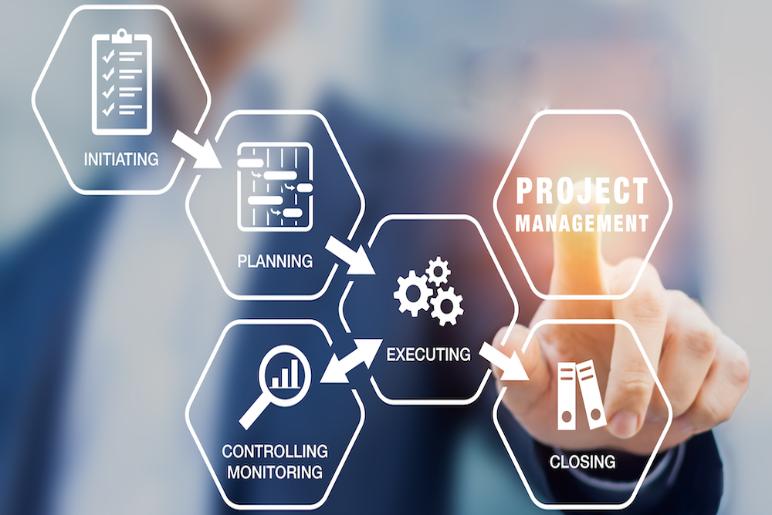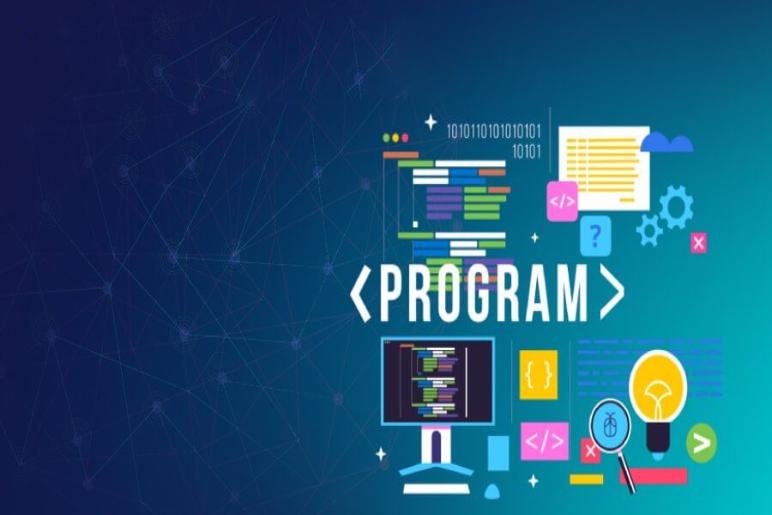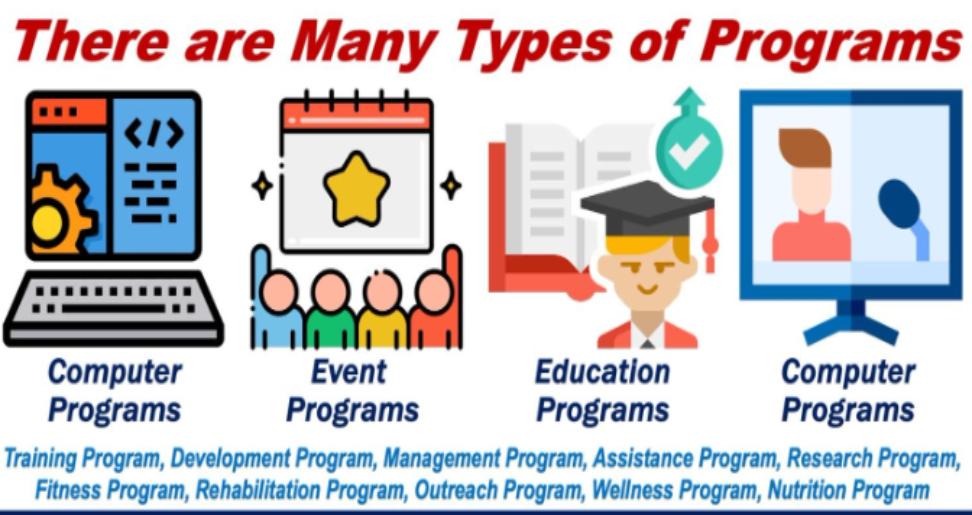A program is essentially a structured plan or course of action designed to achieve a specific goal. It’s a blueprint outlining steps, procedures, or activities to be followed. The concept of programs is pervasive across various fields, from technology to education, government, and entertainment.
Programs in Technology: The Digital Blueprint

In the realm of technology, programs are the lifeblood of digital innovation. They are essentially sets of instructions, written in specific programming languages, that tell computers what to do. These instructions, when executed, bring applications, software, and systems to life.
Types of Programs
- Software Applications: These are programs designed for end-users to perform specific tasks. Examples include word processors, spreadsheets, web browsers, and video games.
- System Software: This type of program manages computer hardware and software resources. Operating systems like Windows, macOS, and Linux fall under this category.
- Programming Languages: While not programs themselves, programming languages are tools used to create programs. They provide the syntax and rules for writing code.
- Mobile Apps: Designed for smartphones and tablets, these programs offer a wide range of functionalities, from communication to entertainment.
- Web Applications: These programs run on web servers and can be accessed through web browsers, enabling tasks like online shopping, email, and social networking.
Programs Beyond the Computer: Real-World Applications

While the term “program” often conjures images of code and software, its applications extend far beyond the digital realm. Let’s explore how programs shape various aspects of our lives.
Education: Building Minds Through Programs
Educational programs are the cornerstone of learning. From early childhood to higher education, these structured plans outline the knowledge and skills students are expected to acquire. Curriculums, lesson plans, and extracurricular activities are all examples of programs designed to foster intellectual growth and development.
Government: Serving the Public Through Programs

Governments implement programs to address societal challenges and improve the lives of citizens. Social welfare programs, healthcare initiatives, infrastructure development projects, and economic stimulus packages are examples of government programs. These initiatives often involve significant resource allocation and careful planning to achieve their objectives.
Business: Achieving Goals Through Programs
In the corporate world, programs are essential for driving growth and efficiency. Marketing campaigns, product development cycles, employee training programs, and quality improvement initiatives are all examples of programs designed to achieve specific business goals. These programs help organizations adapt to changing market conditions and stay competitive.
Other Fields: Programs in Action
Programs are present in countless other areas of life. For instance, fitness programs help individuals achieve their health goals, while rehabilitation programs aid in recovery from injuries or illnesses. Even our daily routines can be considered personal programs designed to optimize our time and energy.
From classrooms to boardrooms, and from government offices to personal lives, programs provide a structured framework for achieving desired outcomes. Understanding the concept of programs across different fields can help us appreciate their importance in shaping our world.
Common Characteristics of Programs

Whether it’s a software application, a government initiative, or a marketing campaign, programs share several fundamental characteristics. Understanding these commonalities can provide valuable insights into their structure and function.
Clear Objectives
Every program is designed with a specific purpose in mind. These objectives serve as the guiding star, determining the program’s scope and direction. Whether it’s to increase sales, improve education outcomes, or enhance public health, the goal is clearly defined.
Structured Framework
Programs typically follow a structured approach, outlining a series of steps or phases. This framework provides a roadmap for implementation, ensuring that activities are organized and coordinated. From planning and development to execution and evaluation, programs often adhere to a systematic process.
Resource Allocation
Effective program execution requires adequate resources. These can include financial budgets, human capital, technology, and physical assets. Efficient resource management is crucial for program success.
Evaluation and Measurement
To determine the effectiveness of a program, evaluation is essential. By setting key performance indicators (KPIs) and collecting data, program managers can assess whether the desired outcomes have been achieved. This information is vital for making adjustments and improvements.
Adaptability
While programs are structured, they must also be adaptable to changing circumstances. Flexibility allows programs to respond to challenges, seize opportunities, and remain relevant.
The Importance of Programs

Programs are the blueprints for achieving goals. Whether it’s a software application, a government policy, or a marketing campaign, programs provide structure, direction, and a roadmap for success.
Efficiency and Organization: Programs streamline processes, allocate resources effectively, and ensure tasks are completed in a logical sequence. This leads to increased efficiency and productivity.
Goal Achievement: Programs are designed with specific objectives in mind. By following a structured plan, organizations and individuals are more likely to reach their desired outcomes.
Decision Making: Programs provide a framework for making informed decisions. By analyzing program data and outcomes, adjustments can be made to improve performance.
Innovation: Programs can foster creativity and innovation by providing a structured environment for experimentation and new ideas.
Accountability: Programs establish clear responsibilities and expectations. This promotes accountability and helps measure progress towards goals.
How to Reevaluate Your Program: A Step-by-Step Guide

Programs evolve over time. What once worked might not be as effective today. Reevaluating your program is crucial to ensure its continued relevance and impact. Here’s a step-by-step guide:
1. Reflect on Your Program’s Goals
- Revisit the original goals: Ensure they still align with your organization’s mission and objectives.
- Evaluate goal attainment: Assess how well the program has met its intended outcomes.
2. Gather Data and Feedback
- Collect data: Analyze program performance metrics, participant feedback, and outcomes.
- Seek stakeholder input: Gather feedback from program staff, participants, and partners.
- Review external factors: Consider changes in the environment, economy, or demographics.
3. Identify Strengths and Weaknesses
- Analyze program strengths: Identify what’s working well and should be maintained.
- Identify weaknesses: Pinpoint areas where the program falls short or could be improved.
4. Set New Goals or Adjust Existing Ones
- Redefine goals: If necessary, modify or replace outdated goals.
- Establish new targets: Set ambitious yet achievable targets for the program’s future.
5. Develop an Action Plan
- Prioritize improvements: Determine which areas require immediate attention.
- Create a roadmap: Outline specific steps to address identified issues.
- Allocate resources: Determine the necessary budget and personnel for implementation.
Challenges in Program Implementation

While programs offer structured approaches to achieving goals, their execution often encounters hurdles. Here are some common challenges:
Resource Constraints
Programs frequently face limitations in terms of budget, personnel, and time. Insufficient resources can hinder program effectiveness and prevent the achievement of desired outcomes.
Stakeholder Management
Balancing the needs and expectations of various stakeholders can be complex. Aligning diverse perspectives and priorities is crucial for program success.
Unforeseen Challenges

Programs often encounter unexpected obstacles, such as economic downturns, natural disasters, or technological disruptions. Adaptability and contingency planning are essential for overcoming such challenges.
Measurement and Evaluation
Determining the appropriate metrics to measure program success can be challenging. Additionally, collecting and analyzing data to evaluate program impact requires time and expertise.
Sustainability
Ensuring the long-term viability of a program is often difficult. Maintaining funding, adapting to changing circumstances, and sustaining stakeholder engagement are key considerations.
Addressing these challenges requires careful planning, effective leadership, and a willingness to adapt. By proactively identifying potential obstacles and developing strategies to overcome them, organizations can increase the likelihood of program success.
Conclusion

Programs, in their multifaceted forms, serve as the blueprints for achieving desired outcomes. Whether in the digital realm, educational institutions, governmental structures, or corporate environments, programs provide a structured approach to problem-solving, goal attainment, and resource allocation. Their ability to outline steps, allocate resources, and establish measurable objectives makes them indispensable tools for individuals and organizations alike. From the intricate logic of computer code to the broad scope of societal initiatives, programs underpin the fabric of modern life, driving progress and innovation.
Read more:
- Alternatives to Payday Loans: Exploring Your Options
- Benefits of Selling Your Decommissioned Data Center Equipment
- Shooting Star vs Inverted Hammer: Understanding the Key Differences and How to Spot Them
Featured Image source: https://tinyurl.com/2e8jbj3m

